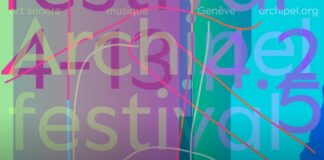Sebbene sia frequentemente associata a fonti sonore esclusivamente elettroniche, la drone music può essere suonata su strumenti acustici con risultati gratificanti. L’ensemble internazionale The Pitch mostra come la drone music acustica può essere composta di elementi timbricamente e armonicamente complessi.
1
Despite its early manifestation as a traditional music made on acoustic instruments, drone is now perhaps most often associated with electronics. To be sure, tambouras, bagpipes, didgeridoos and pump organs and other instruments with long lineages made and continue to make music centered on static tones of long duration. Much of this music is of a traditional or folk type. But there is also a strain of contemporary music that, while informed by a sensibility that has been fostered and facilitated by electronic sound technologies of the last few decades, explores the properties of drones of purely or predominantly acoustic provenance.
2
Contemporary acoustic drone music is rooted in the soil of what La Monte Young termed “the sustained tone branch of minimalism.” Composers and performers associated with this branch, developed during the 1960s, often created sensory environments conducive to, if not directly aimed toward, the elicitation of trances and hypnagogic and other altered states of consciousness. In effect they were engaged in the apparent contradiction of seeking stimulation through monotony.
But contemporary acoustic drone music seems less about facilitating certain states of mind and more about teasing out the implications of the basic insight that pitch, when played on acoustic instruments, is always colored. That is to say that it is always pitch + timbre. Each acoustic instrument has an audio signature based on the overtone structures that emerge when a pitch is sounded; the aggregate of tones we hear as a pitch can, through orchestration, playing techniques and other methods, be manipulated to take on complex audio profiles. Pitch is by nature ambiguous, and much contemporary acoustic drone music exploits and foregrounds this ambiguity.
In this kind of music the drone or constant-pitch tone can serve either one or both of two purposes. It can function as a point of reference in relation to which other tones can interact, creating highly wrought combinations of overtones and emerging timbres; or, when alone and in the absence of other tones, it stands as the one variable held constant while others change. These other variables—timbre, dynamics and duration—then replace pitch relationships or harmonic movement as the vehicles of motion. (Given the static nature of the pitch content, one might think of this as lateral rather than forward motion.)
3
The Pitch, a Berlin-based ensemble whose core members are Boris Baltschun (electric pump organ), Koen Nutters (double bass), Morton J. Olsen (vibes), and Michael Thieke (clarinet), is a predominantly acoustic group creating—oddly, it might seem—drone music out of harmonically elaborate elements. The core quartet is often supplemented in performance by other musicians to form a “frozen orchestra”; at the 2012 Sonic Acts Festival in Amsterdam they were joined by Lucio Capece (bass clarinet), Johnny Change (violin), Robin Hayward (tuba), Chris Heenan (contrabass clarinet), Okkyung Lee (cello), and Valerio Tricoli (Revox reel-to-reel tape machine). The single long performance of “Frozen Orchestra (Amsterdam),” divided in two in order to fit the sides of an LP, builds its drone effects through knotty sound blocks constructed of densely packed, moving clusters of stacked pitches often microtones apart. Although multiple pitches are always active the sound is fused to the point of coming across as a core pitch—itself moving almost imperceptibly–encased in undulating layers of variegated timbres. The combination of tones often makes for harmonic ambiguity, but at one point a simple A major chord precipitates out of the sound mass and then slowly dissolves back into the aggregate. Orchestration is a central element in The Pitch’s raveling and unraveling of sound blocks. The substantial presence of low-compass instruments might be expected to color the performance in dark, opaque tones, but the ensemble sound can be rather bright with a jangling, tamboura-like tint at its outer edges, as it were. At times it sounds like a polyphonic super-instrument of a previously unknown type.
4
The paradox of “Frozen Orchestra (Amsterdam)” is the paradox of a static form made of unstable elements. Massed long duration tones give the impression of sound at a standstill, but within the mass at the local level tones are constantly moving. This is a consequence of the group’s using multiple and moveable clusters of pitch sets as elementary building blocks. Thus as a drone work the piece is seemingly at odds with itself, its macrocosmic sound being one thing—constant—and its microcosmic sound being something else altogether—constantly changing. The drone tones serve as points of reference but as with veiled language the reference is multivalent and always in play, its ultimate object perpetually deferred.







